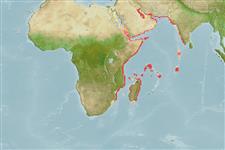Common names from other countries
Classification / Names / Names
Populaire namen | Synoniemen | Catalog of Fishes (gen., sp.) | ITIS | CoL | WoRMS
Environment: milieu / climate zone / depth range / distribution range
Ecologie
; diepteverspreiding 0 - 24 m (Ref. 107695). Tropical
Western Indian Ocean.
Length at first maturity / Size / Gewicht / Leeftijd
Maturity: Lm ? range ? - ? cm
Minimum depth from Ref. 1726. Intertidal to shallow subtidal. Found under medium-sized granite rocks or dead coral slabs, slightly buried in coarse sand (Ref. 1726). Most chitons are microphagous feeders that consume fine algae and other organisms they scrape via their radula (Ref. 833).
Life cycle and mating behavior
Geslachtsrijpheid | Voortplanting | Kuitschieten | Eieren | Fecundity | Larven
Members of the class Polyplacophora are mostly gonochoric. Life cycle: Eggs hatch into lecitotrophic planktonic trocophore larvae (no veliger stage) which later metamorphose and settle on the bottom as young adults.
Dell'Angelo, B., A. Bonfitto, M. Taviani and B. Sabelli. 2003. (Ref. 703)
Status op de Rode Lijst van het IUCN (Ref. 130435)
Status bij CITES (Ref. 108899)
Not Evaluated
Not Evaluated
Gevaarlijk voor mensen
Harmless
Gebruik door de mens
| FishSource |
Tools
Meer informatie
Populaire namenSynoniemenPredatorsVoortplantingGeslachtsrijpheidKuitschietenFecundityEierenOntwikkeling van de eieren
Leeftijd/Grootte
Groei
Lengte-gewicht parameters
Lengte-lengte parameters
Morfologie
Larven
Abundantie
Internet-bronnen
Estimates based on models
Preferred temperature
(Ref.
115969): 26.2 - 29, mean 27.5 (based on 543 cells).
Prijsklasse
Unknown.
